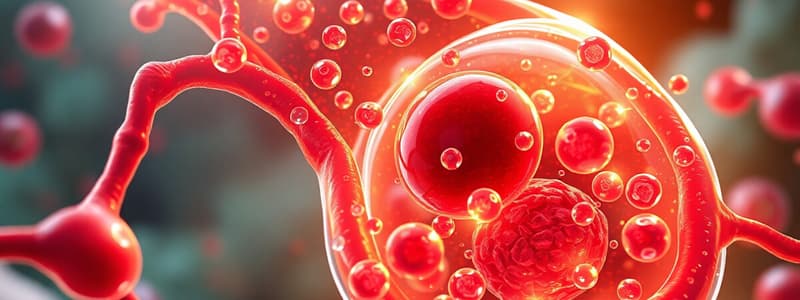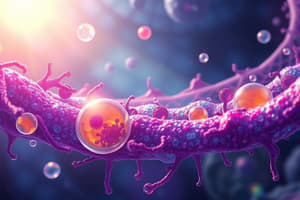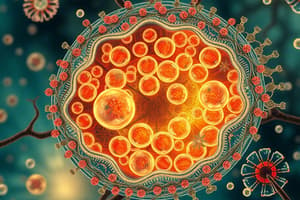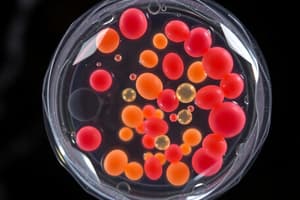Podcast
Questions and Answers
What is a primary function of the Golgi Complex?
What is a primary function of the Golgi Complex?
- To process, sort, and deliver proteins (correct)
- To produce energy by generating ATP
- To remove debris using digestive enzymes
- To provide structural support to the cell
Which organelle is primarily responsible for ATP production?
Which organelle is primarily responsible for ATP production?
- Mitochondria (correct)
- Lysosomes
- Centrosome
- Endoplasmic reticulum
What role does the endoplasmic reticulum play within the cell?
What role does the endoplasmic reticulum play within the cell?
- Digests waste materials
- Serves as a transport channel (correct)
- Absorbs sunlight for energy production
- Forms the structure of the cell
Which of the following substances is stored in adipocytes?
Which of the following substances is stored in adipocytes?
What is the primary function of lysosomes in a cell?
What is the primary function of lysosomes in a cell?
How does the cytoskeleton contribute to cellular function?
How does the cytoskeleton contribute to cellular function?
Which statement accurately describes the role of centrosomes in the cell?
Which statement accurately describes the role of centrosomes in the cell?
What is the function of glycogen in the body?
What is the function of glycogen in the body?
What is the main protective role of melanin in the skin?
What is the main protective role of melanin in the skin?
Which component of the cell is responsible for transporting various substances?
Which component of the cell is responsible for transporting various substances?
What is the primary role of the phospholipid bilayer in the plasma cell membrane?
What is the primary role of the phospholipid bilayer in the plasma cell membrane?
Which component of the plasma membrane is responsible for recognizing other cells and substances?
Which component of the plasma membrane is responsible for recognizing other cells and substances?
What characteristic of the plasma cell membrane contributes to its selective permeability?
What characteristic of the plasma cell membrane contributes to its selective permeability?
What function does cholesterol serve within the plasma cell membrane?
What function does cholesterol serve within the plasma cell membrane?
Which of the following substances can easily pass through the plasma membrane due to its selective permeability?
Which of the following substances can easily pass through the plasma membrane due to its selective permeability?
What is the main function of ribosomes in a cell?
What is the main function of ribosomes in a cell?
Which component of the cell is primarily responsible for excretion and packaging of waste materials?
Which component of the cell is primarily responsible for excretion and packaging of waste materials?
In what way does the plasma cell membrane facilitate contact with other cells?
In what way does the plasma cell membrane facilitate contact with other cells?
What is the role of glycolipids in the plasma membrane?
What is the role of glycolipids in the plasma membrane?
Which of the following best describes the cytoplasm's composition?
Which of the following best describes the cytoplasm's composition?
Flashcards
Endoplasmic Reticulum (ER)
Endoplasmic Reticulum (ER)
A network of interconnected membranes that serves as a surface for chemical reactions, a transport channel, and a storage site for synthesized molecules.
Golgi Complex (Apparatus)
Golgi Complex (Apparatus)
Organelle that processes, sorts, and delivers proteins to various parts of the cell, and also helps package and secrete lipids.
Mitochondria
Mitochondria
Powerhouses of the cell, producing ATP (adenosine triphosphate), the primary energy currency.
Lysosomes
Lysosomes
Signup and view all the flashcards
Centrosome
Centrosome
Signup and view all the flashcards
Centrioles
Centrioles
Signup and view all the flashcards
Melanin
Melanin
Signup and view all the flashcards
Glycogen
Glycogen
Signup and view all the flashcards
Lipids
Lipids
Signup and view all the flashcards
Mucus
Mucus
Signup and view all the flashcards
Plasma Membrane
Plasma Membrane
Signup and view all the flashcards
Phospholipids
Phospholipids
Signup and view all the flashcards
Glycolipids
Glycolipids
Signup and view all the flashcards
Membrane Proteins
Membrane Proteins
Signup and view all the flashcards
Cholesterol
Cholesterol
Signup and view all the flashcards
Cytoplasm
Cytoplasm
Signup and view all the flashcards
Organelles
Organelles
Signup and view all the flashcards
Nucleus
Nucleus
Signup and view all the flashcards
Ribosomes
Ribosomes
Signup and view all the flashcards
Selective Permeability
Selective Permeability
Signup and view all the flashcards
Study Notes
Cell Structure and Function
- The cell membrane is a lipid bilayer composed of phospholipids with hydrophilic heads and hydrophobic tails.
- Glycolipids are on the outer surface of the membrane.
- Proteins are embedded in the lipid matrix, some spanning the entire membrane or anchored to one side.
- Cholesterol stabilizes the membrane.
- The plasma membrane acts as a flexible boundary, separating the cell's contents from the external environment.
- It facilitates contact with other cells and receives signals from hormones, etc.
- The membrane is selectively permeable, allowing some substances to pass through more easily than others (based on size, solubility, and charge).
- The cytoplasm contains water, proteins, carbohydrates, lipids, and inorganic substances.
Organelles
- Nucleus: Contains DNA and RNA for protein synthesis control.
- Ribosomes: Made of rRNA and are responsible for protein synthesis. They are found on the rough endoplasmic reticulum.
- Rough endoplasmic reticulum (RER) : Provides surface area for chemical reactions, acts as a transport channel, and stores synthesized molecules. It is studded with ribosomes.
- Smooth endoplasmic reticulum (SER): Another part of the endoplasmic reticulum system involved in various processes including synthesis and storage.
- Golgi complex: Processes, sorts, and delivers proteins and lipids to their destinations in the cell.
- Mitochondria: Produce ATP (energy) for the cell.
Cell Inclusions
- Melanin: Pigment in skin, hair, and eyes, protecting against UV rays.
- Glycogen: Polysaccharide stored, converting to glucose as needed.
- Lipids: Stored in adipocytes for energy production.
- Mucus: Lubricates and protects.
- Lysosomes: Contain enzymes to remove cellular debris.
- Centrosomes: Contains centrioles, involved in cell division.
Cellular Processes
- Glycolysis: Breaks down glucose to pyruvate.
- Krebs cycle: Also called the citric acid cycle, further breaks down the products of glycolysis for energy.
Studying That Suits You
Use AI to generate personalized quizzes and flashcards to suit your learning preferences.




